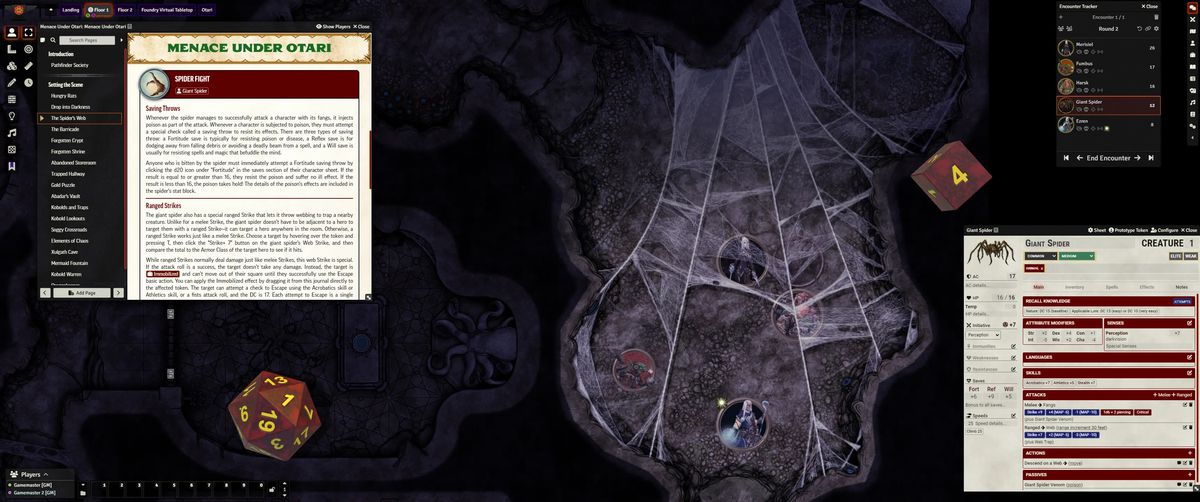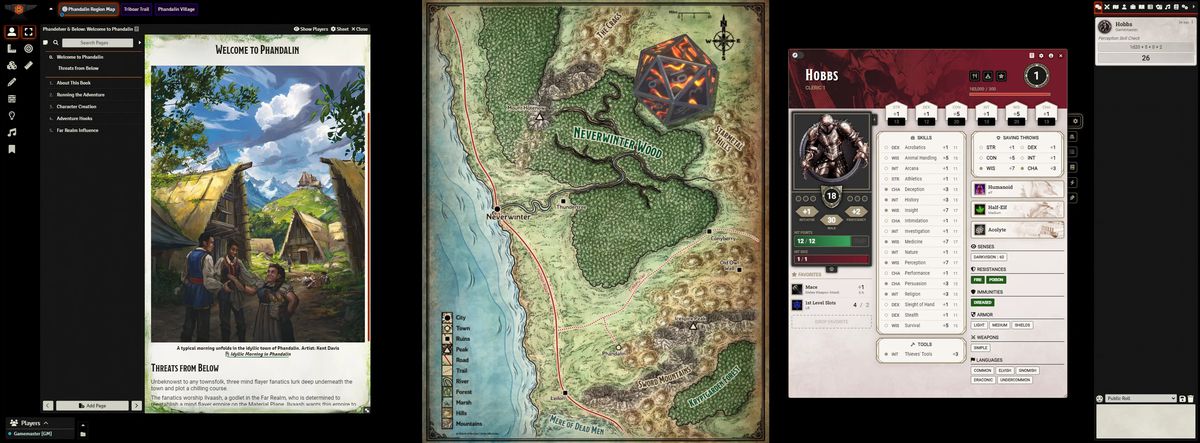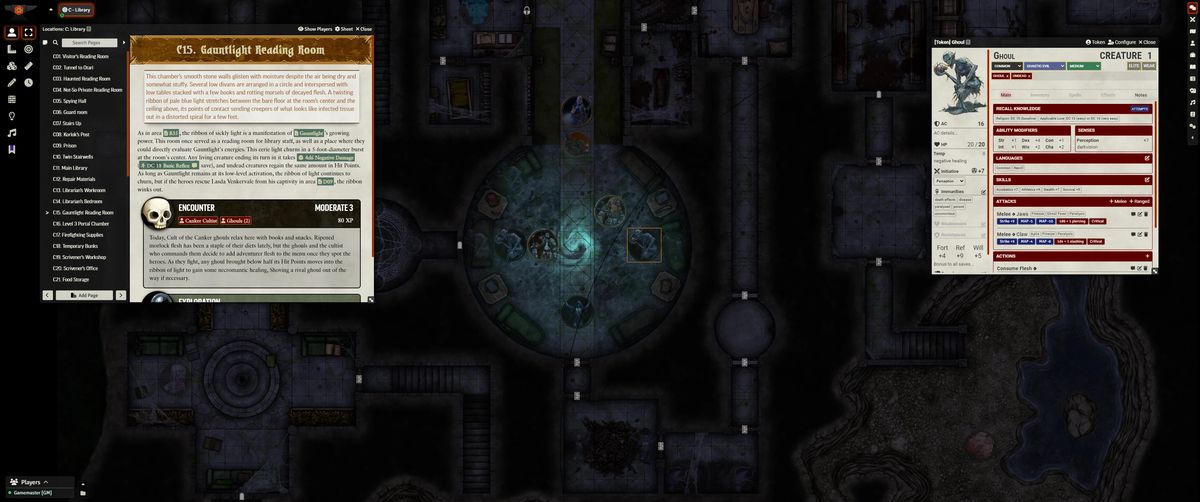Foundry Virtual Tabletop takes the online gaming experience to the next level
I first came across Dungeons & Dragons in the middle of the COVID-19 pandemic, which obviously meant my group started online. This was especially helpful because most of my group members are spread around the world. Every few weeks we get together for a Discord call instead of around a physical table to roll dice and tell stories. And we usually do this via a virtual tabletop, a platform that allows us to move character tokens around a map, roll virtual dice, and (perhaps most importantly for some of my group members) do simple math.
A few months ago my Dungeon Master announced that we would be trying something new for our next arc. Instead of logging into our regular virtual tabletop, it sent a strange-looking link and told us that our passwords were just our first names.
It took a second to figure out how to move our character icons and scroll around the screen, but once we did, we started exploring. We quickly realized that depending on where our character icons were on the map, we as players saw different parts of the map unfold. A few characters explored ahead, while others stayed behind in the harbor. A marketplace unfolded for those who looked ahead, and the rest of us immediately rushed to follow.
When we finally started our first battle on this new platform and performed our first attacks, we gleefully realized that animations were involved. My eldritch blast came out a blinding purple and shot straight at the sentient mushroom I was trying to hit. (And then we had a quick detour where we just spammed attacks to see how they came out, because that’s all So cool).
We were all dazzled by Foundry Virtual Tabletop, as we heard it was called. And our DM seemed pretty jazzed about making the game more interactive. He’s always been passionate about enabling voice modifiers and queuing music, but with Foundry VTT everything has been taken to the next level just now so much more.
Image: Foundry
Intrigued by the new capabilities on display, I chatted with Foundry VTT creator Andrew Clayton about the upcoming virtual tabletop system, which celebrated its fourth anniversary this month. Like many tabletop players, Clayton moved his games online when in-person scheduling became difficult. The virtual tabletop options out there worked decently enough, but he couldn’t help but discover some lost potential.
“I found them quite restrictive in ways that I personally found frustrating,” Clayton explains. “And because I was in a position at the time between hobbies (and) between small hobby projects, I had a kind of, I guess, hubris, you might say, to ask the question of, like: What if I try to make something?”
He never really intended to create Foundry VTT; but after experimenting, Clayton realized there was something of value in it and decided to pursue it further. One of his biggest goals was to increase the immersiveness of the virtual experience as much as possible. The possibilities at Foundry are much greater than at other VTT spaces.
On the game master’s side: Foundry VTT is a one-time purchase for DMs that allows them to download the software and host a server for an unlimited number of players, who can access it via a link. There is only one purchase level, which includes all existing Foundry VTT features, all future updates and no subscription fees. And unlike other virtual tabletop experiences, Foundry VTT doesn’t require players to sign up for anything.
Foundry VTT has all the basics you need for a virtual tabletop: character sheets, dice rolls (which does all the math for you), cards, and tokens to move through the cards. But the software also offers an opportunity for DMs to get Real immersive, with dynamic lightning, visual and audio effects and other features that bring an adventure to life.

Image: Foundry
It’s all pretty invisible to the players. Now that our group is fully involved in Foundry VTT, we mostly move around our own icons, exploring the map and discovering new elements along the way. Combat takes on an extra cool level when attacks produce animations aimed at the enemies we click on. The basic elements of a virtual tabletop are all present, but just expanded and provided with more immersion options.
For example, in one particularly climactic moment, my group watched a snow effect fall across the landscape as a queen made a big announcement. And then, as she spoke, the snow turned gold – signaling war on the horizon. We all gasped and cried (especially because we may have accidentally started the war – oops!). All this was done via a particle effect already integrated into it Foundry VTT (with the help of a few mods, my DM adds).
Mods are an important part of the Foundry experience. Clayton decided early on that he wanted to target Foundry VTT at super developers, allowing community members to create various mods for the existing software to help integrate their favorite gaming systems. As a mod developer, this was very important to Clayton. And by opening the doors for mod developers to use Foundry as a springboard, an exceptionally creative and passionate community ultimately emerged – ultimately paving the way for the company’s first major collaboration with Cubicle 7 for Warhammer fantasy roleplaying game‘s fourth edition.
“Huge IP, huge franchise, huge game system, huge publisher,” says Clayton. “By all accounts, this should not have been one of our first successes. (…) But part of the reason this happened was because the community developers who created the Warhammer Fantasy system for Foundry had just done such an amazing job of making it an absolutely stunning visual gaming system that feels of Warhammer authentically channels. It was just such a strong sales pitch that got them excited and on board.”
That first big win, built on top of user-generated content, opened the door to other publisher partnerships, including most recently D&D publisher Wizards of the Coast. It’s a relationship that Clayton wasn’t sure would ever happen.
“I had actually reached a point where I was comfortable with the fact that it might never happen,” Clayton says. “I think (resignation) was necessary to create (the partnership).”
I didn’t even realize how integral the official D&D integration was until I remembered how when I add new spells to my worksheet, all I have to do is search for them and click “add.” The information from the sourcebooks that my DM owns is already integrated into the server. Since my campaign is largely homemade, with a setting created by my DM, we don’t make much use of existing reference material, but Clayton showed me how easy it is to pull up source guides for specific games, campaigns, and settings. He also showed how seamless it is to jump between different written materials. It’s also very convenient to show information to just one person at a time (or a handful, depending on who gets to know it), which makes the experience all the more immersive.

Image: Foundry
Foundry VTT has a bit of a learning curve, something Clayton readily admits. Even on the player side there is one lot continuing with the user interface, which makes it a bit tricky to get used to. But Clayton compares it to Photoshop or Canva. Foundry is a tool that ultimately offers more freedom and flexibility once you get past the first hurdle of figuring it out.
“I’m very aware of what Foundry can do,” he says. “What amazes me and really blows me away is when a community developer actually leans into that, really takes advantage of it and pushes the boundaries of what’s possible in a really exciting way.”
For example, Foundry VTT is primarily intended to present 2D maps and spaces. But there are people who have managed to use it to convey 3D environments. There are also developers who have managed to put together complex script sequences – much more than just turning some snow a different color – that take full advantage of the software’s audio and visual capabilities.

Image: Foundry
“We know that that kind of customization is possible,” says Clayton. “But knowing that it can be done, and then seeing someone actually take the time to make it and make it work that way, is really inspiring.”
So should your weekly in-person gaming group consider making the move online? Clayton believes that some aspects of virtual tabletops actually overshadow in-person play. Maybe there’s a big meeting on the horizon and your DM wants to try to do something special. But even planning matches between players can be made much easier, especially remotely, when you do everything online. (“That’s at the top of the list (of bullet points),” Clayton jokes.)
But there’s also the simple fact that mechanically dense games are easier to analyze if the material is easily accessible without having to crack open a sourcebook or look up a bunch of FAQs and databases on the Internet.
What really struck me personally as a player over the past few months is how much Foundry VTT embraces its digital roots, allowing GMs to virtually build out their environment and make it as dynamic as possible. The online space is not a limitation; it is a starting point.
“The ceiling (for creative people) is much, much higher,” Clayton says. “I think people probably think of the spectacular sets they have at a show Important role, where it’s this awesome terrain and (custom) miniatures for each creature. (…) The amount of work and production effort that went into this event is completely impossible for absolutely anyone who is not a professional company organizing that production. But I think it’s much easier to have something that approaches that level of immersion in a digital environment (using a VTT).
For what the software can do, it is not very demanding on a computer. As a player, it’s all integrated into a browser, so all I have to do is click a link. Of course, it depends on how complex the GM wants to make the experience, but Clayton wants to be absolutely sure that Foundry VTT’s capabilities are balanced with its performance, without sacrificing one for the other.
“That’s something I want us to continue to build on and invest in,” Clayton said. “So that remains an area where we are the superior choice for a group that wants to tell a very visually rich, very immersive game with very high production value.”
A Foundry Virtual Tabletop license is available for $50.
